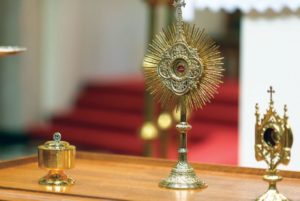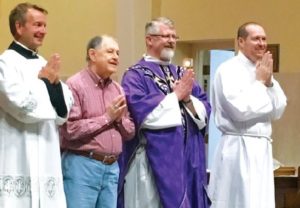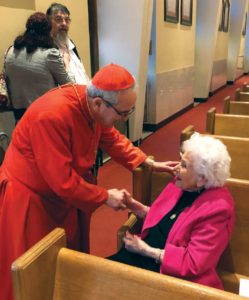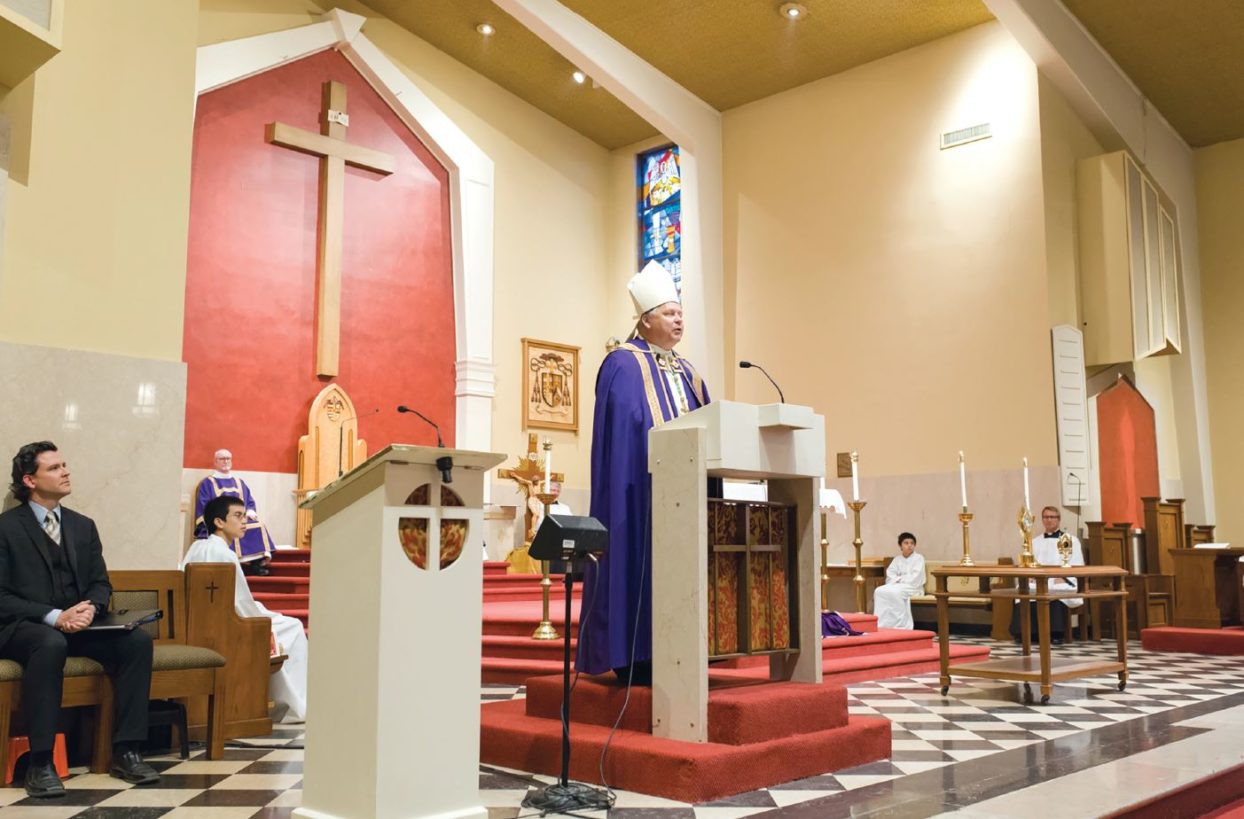Bishop Stika presides at vespers with Cardinal Rigali as building’s 61-year service as a church comes to an end
By Dan McWilliams
Photography by Stephanie Richer Photography
Celebrations at the original Sacred Heart Cathedral occurred on more than 3,200 Sundays in its 61-year history.
The final Sunday celebration happened Feb. 25 as Bishop Richard F. Stika led a vespers service featuring the relics from the old cathedral’s altar and the relics for the new Cathedral of the Most Sacred Heart of Jesus, dedicated March 3. The only remaining celebrations at the old cathedral, which will be converted to a parish hall, were daily Masses from Feb. 26 to March 1.
Bishop Stika presided at the vespers with Cardinal Justin Rigali attending in choir. Deacons Dan Alexander and Bill Jacobs and master of ceremonies Father Joe Reed assisted, with Sister Anna Marie McGuan, RSM, proclaiming a reading and Glenn Kahler serving as cantor. The opening procession was flanked by a Fourth Degree Knights of Columbus honor guard.
 “This is, as bishop, the last time that I will use this ambo, this pulpit, to preach,” Bishop Stika said in his homily at the vespers. “As we gather together on this day that the Lord has given to us, when we have heard the words of the Transfiguration in the Gospel this weekend, and as we celebrate evening prayer, it’s just a reminder of who we are. …
“This is, as bishop, the last time that I will use this ambo, this pulpit, to preach,” Bishop Stika said in his homily at the vespers. “As we gather together on this day that the Lord has given to us, when we have heard the words of the Transfiguration in the Gospel this weekend, and as we celebrate evening prayer, it’s just a reminder of who we are. …
“In a few days, this church, this cathedral church, this mother church of the Diocese of Knoxville, will no longer be a church, nor a cathedral, because, at some point early on in the dedication ceremony of the new cathedral, a decree will be read by Archbishop Christophe Pierre, the apostolic nuncio, the ambassador from the Holy Father, his personal representative to the Church in the United States, in which the pope himself transfers the title of the cathedral church from this building to the next: the Cathedral of the Most Sacred Heart of Jesus.”
The old cathedral was built in 1956 and dedicated in January 1957.
“It began a long and faith-filled journey of baptisms and funerals and weddings and prayer services — all the things parish churches do and host and celebrate, and then, at one particular time, on May 27, 1988, Pope St. John Paul II designated this church as a cathedral,” Bishop Stika said. “And then we began to celebrate the diocesan celebration on Sept. 8, when Bishop Anthony J. O’Connell was consecrated a bishop. And thus we began a wonderful journey.”
The bishop asked, “What makes a church a church?”
“It is a designated place. It is a blessed place,” he said. “But it’s also where the people of God gather together around the table of the Lord, the altar, to celebrate the great mystery of the Eucharist, the body and blood of our Lord Jesus Christ. It is where the Church gathers together to celebrate the sacrament of baptism, of confirmation, of all of those sacramental moments in which God becomes one with us, especially in the Eucharist, but in a variety of different ways. We are nourished, we are fed, we are educated, and we are formed by the teachings of the Church in this noble building for all those years.
“But soon it will be used for another purpose, as it is transferred from a sacred space to a place where we will gather in another sacred way, for we will gather together as community, for this will become a parish hall so desperately needed.”
Bishop Stika said, “This noble space will continue to build and to form what we call community in a variety of different ways, not in sacred space per se, but in community- building and community celebration. For so often when we travel now to the new cathedral, when we are nourished by the Eucharist, then we will come here, and, in many ways, we will be nourished by meals and friendship and all that which makes who we are what we are, for where two or three are gathered, there Jesus is present in our midst. So the journey begins.”
The transfer of relics to the new cathedral marked “a tie-in to tradition and to history, a tie-in to something that’s greater than ourselves, as individuals, as a parish, as a diocese, as a country, of this century, of this year,” the bishop said.
Contained in the altar of the old cathedral were the relics of two saints: Pope St. Clement and St. Laetus.
The first relic for the new cathedral “is a precious gift from Jesus himself via Cardinal Rigali: a splinter of the cross of Jesus Himself, the true cross,” Bishop Stika said. “You know how you know something is legal is there are papers, that Rome says this is authentic. … So we’re very grateful to the cardinal for this precious gift that he’s had for a long, long time, the cross of Jesus. By His cross and resurrection we are set free.
“Also through a gift of Cardinal Raymond Burke, who was my archbishop [in St. Louis] for a year after Cardinal Rigali got traded to Philadelphia, he gave me a very precious gift, the gift of St. Andrew the Apostle, the brother of St. Peter.”
Other relics going to the new cathedral were those of St. Maria Goretti, Blessed Stanley Rother, Pope St. Pius X, Pope St. John XXIII “and, my favorite, Pope St. John Paul II,” Bishop Stika said.
Additional relics are from St. Elizabeth Ann Seton, St. John Neumann, St. Frances Xavier Cabrini, St. Charbel Makhlouf, St. John Bosco, St. Faustina, St. Margaret Mary Alacoque, St. Teresa of Kolkata, St. Josemaría Escrivá, St. Gemma, and St. Mary Magdalene de Pazzi.
“Bits and pieces of lives, as we have bits and pieces of relics, that remind all of us that we can be saints, maybe not canonized like these men and women, but that all of us are called to holiness,” the bishop said.
“My favorite definition of a saint is one who realizes they truly are a sinner.”

Larry DeWine, second from left, is recognized at the last Mass in the original Sacred Heart Cathedral. Mr. DeWine was an altar server at the very first Mass in Sacred Heart Church in 1956. Joining him in front of the altar are from left, acolyte Jerry Bodie, Father Joe Reed, and altar server Scott Barron.
The diocese has grown from 33,000 Catholics in 1988, when Sacred Heart became a cathedral, to more than 72,000 now, according to Bishop Stika.
“We’re a growing Church, we’re a vibrant Church, we’re a Church that can make a difference in the lives of Catholics and non-Catholics,” he said. “You see, we can be transfigured from a sinner to a saint. You know, for those who are sad about moving from this church, I reminded people earlier in the day that St. Peter just wanted to stay on that mountain. He saw Jesus as the Son of God.
He heard the voice from the heavens. He saw Elijah and Moses. He just wanted to stay there, and some people probably will prefer just to stay here.
“But we’re part of the journey, the journey of growth, the journey of building a parish in the diocese, and the journey of celebration. So next week, next Friday night [at vespers on March 2], we will gather together with these same relics in the new cathedral to have some holy and special time with them. It will be our inauguration of the cathedral, even though it’s not dedicated or consecrated yet.”
The bishop said, “We give thanks to almighty God for this noble building, but we look to a future that is filled with bright promise and hope, for it’s about Jesus.”
A procession of the relics to the new cathedral did not happen at the Feb. 25 vespers because of concerns about the weather and about the new building’s doors. Instead, Cardinal Rigali, carrying the relic of the true cross, and Bishop Stika, with the relic of St. Andrew, led a procession of relics outside the old cathedral and back in, where people could venerate the relics after the service ended.
“That [procession] terminates this cathedral church unofficially until next Saturday to the pope’s declaration,” the bishop said. “It terminates this noble and wonderful experience that we call Sacred Heart Church, built in 1956, as our cathedral church.”
Cathedral Rector Father David Boettner said the final vespers “is not a sad event. It’s a time when we say goodbye so that we can say hello. Closure is not easy. We’ve celebrated so many beautiful things here.
“This morning there were people who were a little teary. I was teary watching all these people come up at Communion time, at the 9 o’clock Mass, remembering all the people walking up and all their stories, and knowing all the moments we’ve celebrated together: the funerals, the weddings, the baptisms, all these different times.”
The original cathedral “has been a source of grace for thousands and thousands of people over those 62 years,” Father Boettner said. “So that’s something to celebrate, but it’s also kind of hard to let go and move on to the next stage and the next phase. It’s a beautiful thing.”
Father Christopher Manning, chaplain at Knoxville Catholic High School, grew up in Sacred Heart Parish and made sure to attend the final vespers.
“My family moved to Knoxville when I was in third grade, so we’ve been attending Sacred Heart since 1990,” he said. “It’s where I grew up, where I received confirmation. My sister received first Communion and confirmation here. I was ordained to both the diaconate and priesthood here. I wanted to make sure I was here as we come to the close of one chapter of the diocese’s history and be here next week for the start of a new one.”
The 1956 building has meant a lot to Father Manning.
“It has. I did find myself thinking back, especially to my ordination, and thinking about all the Masses and prayer the building itself has witnessed and will continue to stand testament to,” he said. “I was just talking with a family about how the prayers and the blessings and the sacraments that the brick and mortar themselves have witnessed to will continue to be a witness to as it moves from church to parish hall.”
The vespers service was a sad occasion for Father Manning, he said.
“It was. There was a moment of definitely a lot of emotion, realizing that it is indeed changing. Change and transformation are always hard, but we know that in Christ is the future, and it is that blessing of what tomorrow can and indeed will bring.”

Cardinal Justin Rigali greets Elizabeth “Tutter” McCabe at the final vespers service for the original Sacred Heart Cathedral.
The change was “hard but wonderful,” he said.
“Sacred Heart was needing a new church. The diocese was needing a new cathedral. It was the right time. I’m excited for what the future does indeed bring.”
Elizabeth “Tutter” McCabe, who attended the dedication of the original Sacred Heart Church in 1957, also attended the final vespers and the dedication of the new cathedral. Mrs. McCabe said she had “mixed emotions” about the historic events taking place.
“I’ve been here since they opened the doors,” she said. “Every step we’ve taken has been a step forward. It’s just a bit of heaven. My husband was not a Catholic, he was a Presbyterian, but his dearest friend was [Sacred Heart founding pastor] Father [Edward] Dolan. And [Mr. McCabe] died in ’46.
“I’ve been a Catholic all my life, thanks to my mother. I have 10 children, and they’re all good citizens, love each other, put me on a pedestal. All 10 of them went to Sacred Heart School.”
Regarding the dedication of the new cathedral: “You just feel like standing up and singing,” Mrs. McCabe said.

